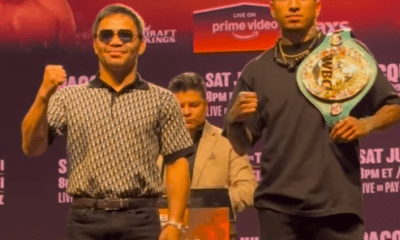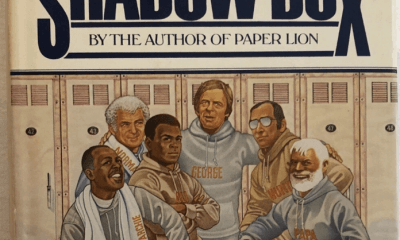Featured Articles
HOW HE DID IT: Alvarado’s Adjustments Gave Him The Win
Mike Alvarado made some shrewd strategic and tactical adjustments that attributed to him defeating Brandon Rios by unanimous decision in their rematch on Saturday night. Although things were reasonably close heading into the final stages of the fight, Alvarado finished the stronger of the two and received the nod on all three of the judge’s scorecards. Today, I’d like to highlight some of the key changes that Mike Alvarado made from the first fight that allowed him to reverse the outcome this time.
Last October, Rios stopped Alvarado in the seventh round after breaking him down in a war of attrition. Although Alvarado (pictured above, right, with Rios, in Chris Farina-Top Rank photo) initially came out looking to angle off his jab and keep Rios at bay, it wasn’t too long before an inside fight erupted. Here, the physically stronger and shorter punching Rios had a significant advantage over the straighter hitting Alvarado. Throughout most of the infighting, what I found interesting was the way in which Alvarado tried to defend himself by hiding behind his lead shoulder. I believe there was a distinct reason for this. In his previous fight before facing Alvarado for the first time, Rios found himself in with underrated lightweight spoiler, Richard Abril. During that fight, in which Rios was very fortunate to have been given the decision, Abril was able to blunt much of Rios’ work because of how effective he was at close quarters using the half-guard defense (Philly shell). Whenever Rios tried to land his right or left hook, Abril would catch the rights on his lead shoulder and roll with them, or he would stuff Rios’ left hook to the body or head by jamming the blow with his right glove or elbow. Used correctly, the half-guard defense is incredibly effective at close range.
Unfortunately for Alvarado, he wasn’t nearly as effective as Abril was in using the half-guard defense on the inside against Rios.
Here’s a look at Alvarado trying to defend against a left hook at close quarters from the first fight.

Alvarado is attempting to stuff a Rios left hook on the inside. Although his arms are correctly positioned in the first still (left arm acting as a barrier by the waist while the right glove and elbow are protecting the chin and right ribs respectively), notice how Alvarado has broken away from his guard slightly in the second still. In this scenario, the correct procedure for blocking a left hook in close should be either to turn your right side in and toward the blow (the opposite methodology of evading a right hand punch by rolling with it), jamming your lower right arm into the crook of your opponent’s left arm, not allowing the hook to pick up a head of steam, or by absorbing the blow on the outside of the right glove. Instead, Alvarado tried to lean away, lowered his right glove and got caught.
Let’s now take a look at a similar scenario in the first fight, but this time the threat is coming from Rios’ right hand.

Here, Rios lands a right hand as Alvarado attempts to roll with the blow. Notice that instead of rolling, Alvarado ends up bending at the waist and leaning forward. The correct way to roll with a right hand should be to lean back slightly on the back foot, rotating the hips and turning the left shoulder in so as to deflect the incoming blow. Not only has Alvarado failed to defend against the right hand here, but he’s also neutralized any chances of him throwing an effective counter.
Although the half-guard defense is good for narrowing a fighter’s profile, it can sometimes cause a fighter to stand too narrowly if they are not careful. For an example of this, you needn’t look any further than Andre Berto’s recent failed attempt at utilizing the half-guard defense effectively against Robert Guerrero. Not only did he fail to use it for its main purpose, which is to defend, but Berto also failed to mount any real offense from it because he was standing too narrowly. Standing too narrowly in the half-guard defense is especially detrimental to the effectiveness of straight or overhand punches coming from the rear hand as they are forced to travel across the body and from a greater distance.
Although it seems fashionable at the moment, the half guard defense is not for everybody. Last time, Alvarado’s defense wasn’t quite tight enough on the inside. Therefore, the decision to abandon the half-guard defense in favor of a more conventional guard was a brilliant one. This helped Alvarado in the following ways:
- It gave Alvarado better protection from both right and left handed attacks in close.
- It allowed Alvarado to land his overhand right (his most effective punch during the entire fight) from a more natural angle.
- It provided Alvarado with the room and freedom to side-step around Rios at close quarters.
- It improved his effectiveness at tying his man up on the inside, which Alvarado could not do successfully last time, but did so on more than one occasion this time.
Here are some examples of these points.

Here’s Alvarado using a more conventional guard (which gives him far better mobility) and stepping around Rios. As long as Rios is being forced to turn on the inside, he can’t generate maximum power on his short punches. This was a far cry from the first fight, in which Alvarado was trying to block and roll with many of Rios’ right and left hand salvos.

Here is a common position that took place throughout the night. Notice the difference in Alvarado’s infighting position in the second fight compared to the first. Here, he was much better equipped to deal with Rios’ left hand by getting slightly lower and standing more horizontal to Rios. Again, the half guard stance, although very effective at this range when used correctly, is not a one-size-fits-all defense. Alvarado was better off without it.
Here is another look at the effectiveness of Alvarado’s change of guard

In the first fight, Rios was able to sneak his overhand right over the top of Alvarado’s lead shoulder. It essentially won the fight for Rios. Notice how the different guard gives Alvarado much better protection against the right hand. In the rematch, Rios’ right hand was often blocked by the outside of Alvarado’s left glove.
For me, the most significant thing that transpired as a result of the change in guard from Alvarado was his overhand right. Because of his narrower guard in the first fight, the effectiveness of Alvarado’s back hand was at times compromised. In the rematch, however, because of the more horizontal guard, Alvarado was better able to dip low and arc his right hand around the guard of Rios.

Here’s Alvarado dipping low and coming over the top with his overhand right. Notice how Alvarado’s head is away from the centerline as he connects. By contrast, look at Alvarado’s body alignment in the final still. He’s in no position to even throw an overhand right, let alone connect with one.
The overhand right of Alvarado was the most prominent weapon of either man throughout the fight.

Here’s Alvarado landing his overhand right on Rios at different stages during the fight. Notice how low Alvarado gets as he’s throwing. By changing levels and taking his head off line, Alvarado has taken a precautionary measure against a potential lead or counter from Rios. In these situations, when both fighters are punching with each other, the fighter who doesn’t move his head will usually come off second best.
Although I felt Rios abandoned his jab slightly as the rounds went by, and his head movement after punching wasn’t quite as good as it was the first time, Rios more than had his fair share of moments (namely earlier on in the fight as he was advancing behind his hard jolting jab which seriously hurt Alvarado on one occasion). For me though, Alvarado’s tactical adjustments were the deciding factor. By applying more movement this time around, Alvarado was able to distance himself slightly better, which gave him more punching room as well as time in which to set himself for that monstrous overhand right that he continued to unload.
Speaking of which, although he won’t admit to it because of the inevitability of a third contest between the two, I firmly believe that Mike Alvarado’s strategy, as was Juan Manuel Marquez’ when he met Manny Pacquiao in December, was not to try and out box Brandon Rios, but to render him unconscious. And if not for Rios’ world class chin, he would have done that. Yes, Alvarado was certainly using his legs more, but I don’t think it was really his intentions to use footwork as a way to keep turning his opponent and blindside him from a different angle. Nor was it really his intention to stick and move behind a jab. Those overhand rights of Alvarado, not to mention some of his left hooks and uppercuts, would have seriously hurt many a junior welterweight.
Earlier in the night, Terence Crawford did a tremendous job of thoroughly out-boxing Breidis Prescott. In this instance, using footwork and a jab to angle off toward the lead shoulder of his opponent, Crawford’s strategy was clearly to out-box his man and win a decision. There were very few moments during that fight where Crawford remained in front of Prescott long enough for him to set himself. Mike Alvarado, on the other hand, spent most of the night standing right in front of Brandon Rios trying to take his head off. Another look at Alvarado’s body alignment and commitment to his overhand right in the above stills should clarify what his real intentions were.
By moving side-to-side, sporadically switching between the southpaw and orthodox stance, landing occasional thudding hooks to the body which aided in disguising attacks up top, as well as evading Rios’ own hooks by either taking them on the outside of his gloves or by weaving under and out, I felt Alvarado did an excellent job of mixing up both his offensive and defensive patterns so as to remain unpredictable and disguise his real intentions.
Ultimately, Alvarado moved and threw straight punches down the middle to narrow Rios’ guard, before planting his feet and looping that huge right hand around it.
In trying to knock him out, Mike Alvarado ended up out slugging Brandon Rios across 12 truly compelling rounds in a glorious fight. I can’t wait for more of the same.
-

 Featured Articles3 weeks ago
Featured Articles3 weeks agoAvila Perspective, Chap. 330: Matchroom in New York plus the Latest on Canelo-Crawford
-

 Featured Articles1 week ago
Featured Articles1 week agoVito Mielnicki Jr Whitewashes Kamil Gardzielik Before the Home Folks in Newark
-

 Featured Articles4 weeks ago
Featured Articles4 weeks agoAvila Perspective, Chap 329: Pacquiao is Back, Fabio in England and More
-

 Featured Articles3 weeks ago
Featured Articles3 weeks agoOpetaia and Nakatani Crush Overmatched Foes, Capping Off a Wild Boxing Weekend
-

 Featured Articles2 weeks ago
Featured Articles2 weeks agoCatching Up with Clay Moyle Who Talks About His Massive Collection of Boxing Books
-

 Featured Articles3 weeks ago
Featured Articles3 weeks agoFabio Wardley Comes from Behind to KO Justis Huni
-

 Featured Articles1 week ago
Featured Articles1 week agoMore Medals for Hawaii’s Patricio Family at the USA Boxing Summer Festival
-

 Featured Articles4 weeks ago
Featured Articles4 weeks agoDelving into ‘Hoopla’ with Notes on Books by George Plimpton and Joyce Carol Oates















